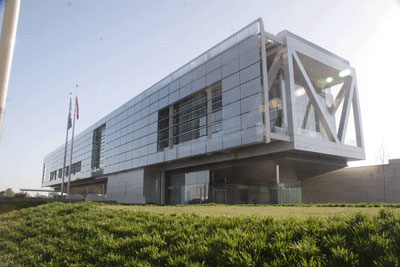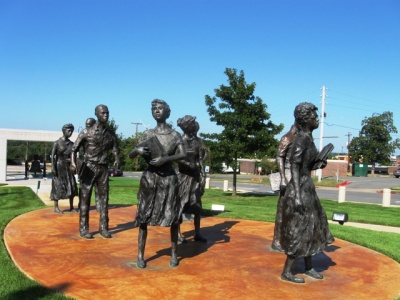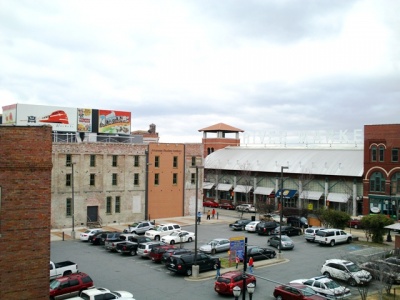Difference between revisions of "Main Page"
Tempaccount (talk | contribs) |
|||
| Line 116: | Line 116: | ||
<tr> | <tr> | ||
<td style="color:#000;"> | <td style="color:#000;"> | ||
| − | The Choctaw Freight Depot was a companion structure to the [[Choctaw Railway Station]] on the grounds of the [[William J. Clinton Presidential Center and Park]]. The [[Choctaw, Oklahoma & Gulf Railroad]] operated the freight depot. The depot was constructed by freed African American | + | The Choctaw Freight Depot was a companion structure to the [[Choctaw Railway Station]] on the grounds of the [[William J. Clinton Presidential Center and Park]]. The [[Choctaw, Oklahoma & Gulf Railroad]] operated the freight depot. The depot was constructed by freed African American slaves under the direction of Charles W. Clark, owner of the Clark Pressed Brick Company in Malvern, and opened to deliveries on April 9, 1900. |
In 1911 the depot was abandoned by the railroad in favor of a larger facility at the corner of East Fourth & Rector. The depot was leased in 1913 to Reaves Transfer Company, to Fisher Cement & Roofing Company in 1939, and again to May Supply Company in 1944. The freight depot spent its last forty years entombed within a number of surrounding May Supply warehouses. [[Eugene Pfeifer III]] was the last owner of the site before being condemned by the [[City of Little Rock]]. | In 1911 the depot was abandoned by the railroad in favor of a larger facility at the corner of East Fourth & Rector. The depot was leased in 1913 to Reaves Transfer Company, to Fisher Cement & Roofing Company in 1939, and again to May Supply Company in 1944. The freight depot spent its last forty years entombed within a number of surrounding May Supply warehouses. [[Eugene Pfeifer III]] was the last owner of the site before being condemned by the [[City of Little Rock]]. | ||
Revision as of 09:05, 8 April 2010
|
|
|
Categories · New Pages · Popular Pages · A–Z index · Bibliography · Timeline |
If Little Rock can be read as a text, then it might be said that this city clings to hope, and endures anguish.
For two centuries the people of Central Arkansas have suffered abundantly. Ashen victims of the violent New Madrid earthquake, the first clutch of Little Rockians resettled here under a relief bill passed in the 1810s. Soon these hardy souls found themselves toe-to-toe with roaming bands of swindlers, mercenaries, and traders, many of them "swallowed up in dram-drinking, jockeying, and gambling." Native Americans, displaced from their homes in the southeastern parts of the nation and ravaged by cholera, passed through here on their way to Oklahoma in the 1830s—leaving behind a "trail of tears and death."
A Bare Living Gained by Great Labor
During the Civil War, Little Rock, population 3,727 (2,874 white, 853 black), was the site of backbreaking military and civilian labor. Paper for making gun cartridges was so scarce that the State Library was ransacked for spare material. Federal occupiers demanded water and feed for their animals, commandeered cattle for meat, and burned what could not be pulled down or removed. Neighbors retreated to the woods for survival as the city was stripped bare. Mercifully, the war ended early in these parts. The Confederate "Last Stand" of the Little Rock Campaign took place on September 11, 1863.
Energetic citizens working alternately in oppressive heat and bitter cold carved civic institutions and backyard gardens out of a snaky riverside wilderness, turning it into a self-declared "City of Roses." But fate was not done with them yet, not nearly so. In 1894 a vicious tornado demolished government buildings and most of downtown. And then in 1927 a Great Flood wiped away roads, bridges, and carefully laid railroad tracks. These were only two of the many dizzying displays of Arkansas' natural infelicity. No wonder these people, eking out an existence in a world of uncertainty, generally remained a prudent and conservative lot.
Crises and Civil Rights
Sometimes the wounds were self-inflicted. Racial violence was one. In the year of the flood a white mob lynched the black John Carter who believed he had assaulted two white women. Carter's body was dragged behind a car and burned on top of a pile of church pews torn from a local African-American church. Enraged and afraid, many black families packed up and left for Pankey, a rural neighborhood so far outside the city that only recently have the suburbs caught up with it.
In the 1950s unprecedented slum clearance forced poor blacks and whites out of their homes and shuttered their businesses, sometimes permanently. Engineers split the Jim Crow-segregated Ninth Street black commercial core with the Wilbur D. Mills Freeway, and planners leveled historic Main Street businesses. Progress had come to the city in the form of the automobile, and dwellers fled and flocked to country cottages and shopping centers. Like so many cities Little Rock's residents exited to the suburbs and exurbs in search of economic prosperity, good schools, and decent living.
A generation of promise was squandered in the 1957 Little Rock Desegregation Crisis, an enduring international symbol of the American Civil Rights movement. Local pillars of the community quaked with fear during the struggle while Governor Faubus convinced many that "[b]lood will run in the streets" if white schools opened to black students. Few wanted to engage in the business of the day in such an inflamed environment, and a legacy of social and economic blackballing endured, burnished by occasional media reports of gang violence, drug abuse, and corruption.
Downtown Revitalization
The 1970s brought new leaders and new ideas into the city, and a spirit of rehabilitation, nourished in no small measure by Bicentennial reflections, buoyed the dreams of many. Not even the wrenching MacArthur Park and Governor's Mansion Historic District cyclone could wipe away the evocative power felt by the preservers of our cherished, but all-too-often displaced, ideals.
And so in the 1990s we could find a Museum of Discovery edging out a store that sold caskets in the decrepit River Market warehouse district, and a festival hall and fresh food market rekindling urban investment. In total, about $1 billion of direct investment touched off a rebirth in our central core between 1997 and 2004, when the gleaming white Clinton Presidential Center came to anchor the new development. That renaissance continues to inspire hope, a hope that spreads out in waves from the six bridges spanning the Arkansas River to Argenta and Stifft's Station, into the hinterlands of Pulaski County, and all the way out to the fast growing regional metropolitan centers of Conway, Benton, and Jacksonville.
Reading between the lines of the Little Rock street grid, we find a pattern of development not so different from that found in other Southern cities. There is the same struggle over civilization and its discontents: the lengths to which the metropolis should or should not imitate an intentional community drawn together by like-minded folk, and how purpose and ideology are expressed in its commercial plans, educational and citizenship facilities, and eco-sustainability. The discordant voices of business leaders, government officials, and residents on these problems are heard here - as they are everywhere.
A New Beginning
The fall of the old Main Street and the rise of the River Market District, however, can be attributed to a particular clutch of aesthetic and utilitarian concerns expressed by people in the city. What things must we have to create our own vision of the American Dream? What things can we – or should we – live without? In twentieth-century Little Rock these concerns clustered around a number of key problems and proposed strategies: blight and its alleviation; crime and its reduction; the spatial reconciliation of automobile, traffic, and parking; entertainment and its convenience; Southern urban living and preservation of a distinctive rural character; clutter and its reduction; the free market and its unfettering; lifestyle and its choosing; and – not least – race and an unprejudiced view towards others.
In January 2006 students in the Honors College at the University of Central Arkansas began the Little Rock Renaissance project to build public knowledge by making new knowledge public. This experimental wiki democratizes our heritage by preserving and reflecting on the memories of the people who made built the city and its environs, as well as important places, events, and signposts along the way. Read more about the development of this wiki in the Fall-Winter 2009 issue of Journal of the National Collegiate Honors Council.
|
|
Little Rock Renaissance Project Collaborators
- Team Leader, Oral History Methods: Phil Frana [pfrana@uca.edu]
- Administration, Grantmaking, Professional Best Practices: Amanda Allen
- Video Production: Eric Deitz
- Administrative Assistant: Blake Bowman
- Production Assistant: Allison Yocum
- Photography: James Hyde, Casey Gambill, Megan Davari, Amanda Allen, Allison Hogue, Nathan Smith, Katy Simers, Wade Fuqua, Nathan Scarborough, Spencer Smith, Austin Keaster, Elizabeth Youngblood, Caroline Borden, Elizabeth Housley
- Interviews: Courtney Bennett, Ben Dobbs, John Greene, James Hyde, Adam Lucas, Ryan Morrow, Fabia Bertram, Blake Bowman, Nicholas Coelho, Megan Davari, Casey Gambill, John Lenehan, Jeremy Morgan, Allison Yocum
- Wiki Administration: Thomas Bertram
- Knowledge Engineer: Megan Davari
- Wiki authors: David Adams, Saroj Adhikari, Marybeth Allinson, Bekah Baugh, Natalie Bergstrom, Fabia Bertram, Thomas Bertram, Caroline Borden, Blake Bowman, Nicholas Coelho, Megan Davari, Tyler Floyd, Sarah Fodge, Rebecca Harvey, Matthew Hill, Casey Gambill, Divy Goel, Michael Hinds, Katelyn Johnson, Austin Keaster, Genevieve Kimbrough, Brandon King, Lauren Knetzer, John Lenehan, Katie Matthew, LeeAnne Maxey, Carlos Merino, Jeremy Morgan, Maegan Murphy, Patricia O'Neal, Desiree Paulhamus, Brannen Payne, Tim Peterson, Caitlin Porter, Micah Ray, F. John Rickert, Hayley Sebourn, Mark Senia, Kendra Stuart, Stephanie Sun, Robbie Toombs, David Wilkins, Allison Yocum, C. Rutledge Wilson, Geoffrey Wright, John Zagurski
Other links of interest
- Clinton Presidential Center site
- Clinton Presidential Library & Museum site
- Arkansas Globecoming
- City of Little Rock site
- Little Rock River Market site
- Downtown Little Rock Partnership site
- Downtown Little Rock stories from the Arkansas Times
- Encyclopedia of Arkansas History & Culture



